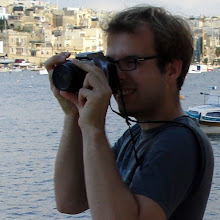The new and nearly-completed Jefferson Clinton Commons, just south-east of the Armory, has caught everyone's attention with the prospect of extending some of the square's vibrancy around to the "far side" of the oval. Look at all that ground floor space, just screaming for the passer-by to be enticed in by the what lies just behind the near-full-height glass. The prominent end of the building has three street frontages -- a perfect anchor space for, say, a small grocery or a trendy new clothing store. As the building pulls away from the curve of the street to the west, the wider space seems to be tailor-made for a future restaurant's outdoor seating. The balconies to the apartments above add just enough activity to the upper floors to catch one's eye and draw them nearer to the excitement below.
Unfortunately, as the story has since unfolded, the pedestrians who are drawn over by the people shooting the breeze or reading on their balconies will only find a series of ground floor windows that are merely allowing the office dwellers within to see the lack of street life immediately outside. In a rather bittersweet move, a well respected marketing firm is taking over the entire ground floor of the building. Although it will surely be exciting to have the creativity of the firm and its employees constantly engaging with Armory Square, it's rather tragic that they chose to take over the street level of a building that could have housed a good handfull of diverse public-oriented businesses. There are a few buildings less than a block away that have completely vacant upper floors could have been the perfect space for an office such as this. Instead, I worry, they're probably going to put up blinds to gain the privacy usually associated with upper floors, privatize the patio area, and become very introverted... effectively leaving the ground floor with nothing to look at or interact with. I really want them to prove me wrong.
As Armory Square continues to expand and densify, drawing in more housing and businesses, there will be ever more people engaged in the street level activity. It's too bad they will be faced with these pocket "dead zones" that they will have to quickly pass by to get to the next thing... if they even have a reason to pass by at all [the Sibley's building, the Atrium garage, and the pinkish radio station/offices on Walton are some other nearby examples of this]. I hope the new building going up just to the north of A.S. lures in some good ground floor tenants to draw some of the activity in that direction. How great would that be to have an active, pedestrian-filled Franklin Street connecting Armory to the Dinosaur, and even beyond to Franklin Square and Little Italy? The potential is growing... lets hope that the developers can follow through and make it really happen.








